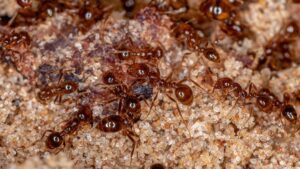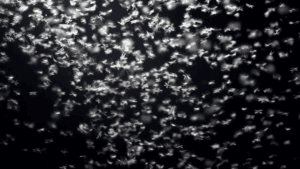Fire ants are small, aggressive insects known for their painful stings. The red imported fire ant is originally from South America and has expanded its presence across the southern United States, reaching as far as Louisiana. Fire ants are one of the most recognizable ants in Louisiana.
Understanding their biology and behavior is crucial to managing them effectively.
Key Takeaways
- Get a complete understanding of fire ants in Louisiana
- Learn how to prevent fire ants from spreading
- Understand how to get rid of fire ants
Table of Contents
Characteristics of Fire Ants
Fire ants are reddish-brown and vary in size from about 1/8 inch to 1/4 inch. They build large mound-shaped nests in open areas like lawns, fields, and pastures. These nests can be quite large, sometimes reaching heights of up to 18 inches, and they are often hidden in plain sight.
Each colony can contain thousands of ants, including a queen who lays eggs to keep the colony thriving. Fire ants are highly organized, with a structured social hierarchy that includes workers, soldiers, and reproductive members. Their ability to quickly mobilize and protect their colony is what makes them particularly challenging to control.
Fire ants are highly adaptive and can thrive in various environments. They like sunny spots and are often seen in disturbed soils, such as those in farm lands and city areas.
Their diet is diverse, ranging from proteins found in other insects to sugars from plants. This adaptability makes them successful invaders. They are also known for their aggressive foraging behavior, which can lead to conflicts with native species.
Fire ants communicate uniquely by using pheromones, which help them signal danger or locate food. This process makes them effective at coordinating attacks and gathering resources.
Fire Ant Behavior and Impact
Fire ants are notorious for their aggressive behavior. When their nest is disturbed, they swarm out to defend it, inflicting painful stings that can cause allergic reactions in some people.
These stings may cause severe allergic reactions called anaphylaxis, which can be life-threatening if not treated right away.
They can damage crops, harm livestock, and even short out electrical equipment. Their existence in farming areas often results in notable economic damage because they can ruin crops like soybeans and potatoes and interfere with farming machinery’s functioning.
Additionally, their mounds can damage lawn equipment and are unsightly in landscapes.
How to Prevent Fire Ants in Louisiana
Prevention is always better than cure when it comes to fire ants. Implementing proactive strategies can help keep these pests at bay and protect your property from infestation.
Maintain Your Yard
Keeping your yard tidy can discourage fire ants from settling in. Regularly mow your lawn, trim bushes, and remove debris like fallen leaves and branches. This reduces the places where ants can build their nests. Creating a barrier by keeping grass short and edges clear can deter fire ants from establishing colonies near your home.
Regular yard maintenance also involves checking for any signs of ant activity, such as new mounds, and addressing them immediately before they become larger problems.
Eliminate Standing Water
Fire ants are attracted to moisture, so it’s essential to fix any leaks and ensure proper drainage in your yard. Overwatering your lawn can also invite fire ants, so be mindful of how much water your garden receives. Installing gutters and downspouts that direct water away from your home’s foundation can help in reducing moisture levels.
Consider using drip irrigation systems for your plants, which provide water directly to the roots without creating excess moisture that could attract ants.
Choose The Right Plants
Certain plants and natural substances can repel fire ants. Consider planting mint, marigolds, or lavender in your garden. These plants not only add beauty to your landscape but also serve as natural repellents due to their strong scents. Sprinkling diatomaceous earth or coffee grounds around your yard can also help deter these pests. Diatomaceous earth is particularly effective as it dehydrates and kills ants upon contact.
Regularly applying these substances along ant trails and around potential nesting sites can create an inhospitable environment for fire ants.
Introduce Natural Predators
In addition to plant-based deterrents, maintaining a balanced ecosystem can help control fire ant populations. Encouraging natural predators, such as certain bird species and beneficial insects, can help keep ant numbers in check.
Introducing nematodes, microscopic organisms that naturally prey on ants, into your soil can also be an effective biological control method. Ensuring that your garden has diverse plant species can create a habitat that supports these natural allies, reducing the likelihood of fire ants dominating your landscape.
Natural and Chemical Treatments for Fire Ants
If fire ants have already invaded your property, several treatment options can help manage them. Choosing the right treatment depends on the severity of the infestation and your personal preferences regarding chemical use.
Fire Ant Baits
Bait treatments are an effective way to control fire ants. These contain insecticides mixed with food that attracts ants. When worker ants take the bait back to the colony, it gradually kills off the entire population, including the queen. Baits are particularly effective because they target the entire colony rather than just the ants visible on the surface.
It’s important to place baits strategically around the perimeter of the infested area and to follow up with regular applications for lasting results. Be patient, as bait treatments can take several weeks to see full effects.
Chemical Treatments
Chemical treatments involve using insecticides directly on the ant mounds. This method can provide immediate results, but it may require repeated applications to ensure all ants are eradicated. Always follow the product instructions and consider hiring a professional for the best results.
Spot treatments with contact insecticides can quickly reduce the number of visible ants, providing fast relief from active mounds. However, care must be taken to avoid harming beneficial insects and plants in the process.
Natural Remedies for Fire Ants
For those who prefer a more eco-friendly approach, there are natural remedies available. Pouring boiling water on ant mounds can kill ants on contact, though it might not reach the queen deep within.
Essential oils like orange or peppermint oil can also be mixed with water and sprayed on mounds. These oils disrupt the ants’ communication and can deter them from returning to treated areas.
Natural remedies often require repeated applications and are most effective when combined with other control methods. Additionally, maintaining a natural garden environment can promote the presence of ant predators, enhancing the effectiveness of natural treatments.
Integrated Pest Management for Fire Ants
Integrated Pest Management (IPM) combines multiple control strategies to effectively manage fire ant populations. This approach includes regular monitoring, using a combination of baits and chemical treatments, and employing natural remedies. IPM aims to minimize the use of chemicals, focusing on long-term prevention and control.
By understanding the specific needs and conditions of your property, you can tailor an IPM plan that effectively addresses your fire ant problem while preserving the health of your ecosystem.
Completely eliminating fire ants can be challenging, but with persistence and the right methods, it’s possible. Consistent effort and a multi-pronged approach are key to achieving long-term success in managing fire ant infestations.
Regularly Inspect & Treat
Regularly inspect your yard for new mounds and treat them promptly. Consistent monitoring helps prevent small infestations from becoming large-scale problems.
Take note of any changes in ant activity and adjust your control methods as needed. Keeping a record of treatment dates and methods used can help you track the effectiveness of your efforts and identify patterns in ant behavior.
Use Multiple Treatment Methods
Using a combination of bait and chemical treatments often yields the best results. Baits work over time to destroy the colony, while chemical treatments can provide immediate relief from active mounds. This dual approach ensures that both surface and subterranean ants are targeted.
Consider alternating between different types of baits and chemicals to prevent ants from developing resistance. Combining methods also allows you to tackle infestations at different stages, from initial identification to final eradication.
Hire a Pest Control Service for Fire Ants
If you’re struggling to control fire ants on your own, consider hiring a pest control service for fire ants. They have the expertise and tools to deal with severe infestations safely and effectively. Professionals can assess the severity of your infestation and recommend the most appropriate treatment plan.
They can also provide guidance on preventative measures to reduce the likelihood of future infestations. Investing in professional help can save time and effort, especially when dealing with large or persistent fire ant problems.
Ongoing Management and Monitoring
Achieving long-term control of fire ants requires ongoing effort and vigilance. Implementing a regular schedule for monitoring and treatment can help maintain a fire ant-free environment. Educating yourself and your family about fire ant behavior and prevention can empower you to take proactive measures.
Consider participating in community efforts to manage fire ant populations, as collective action can enhance the effectiveness of individual efforts. By staying informed and engaged, you can protect your property and contribute to broader efforts to mitigate the impact of fire ants in Louisiana.
Ecological and Economic Impact of Fire Ants in Louisiana
The presence of red imported fire ants in Louisiana has significant ecological and economic impacts. They compete with native ant species and can disrupt local ecosystems. Moreover, their aggressive nature and ability to damage crops and livestock make them a costly problem for farmers.
Red imported fire ants can outcompete and displace native ant species, leading to a reduction in biodiversity. This imbalance can have cascading effects on the ecosystem, affecting other wildlife that relies on native ants for food. Fire ants also prey on ground-nesting birds and small mammals, disrupting local fauna populations.
Their aggressive foraging behavior can alter plant communities, as they protect certain plant species while attacking others. Understanding these ecological consequences is essential for developing effective management strategies that preserve the integrity of local ecosystems.
Farmers need to be vigilant in monitoring and managing fire ant populations to protect their crops and livestock. Integrated pest management strategies, which combine biological, cultural, and chemical controls, are often the most effective. Fire ants can cause significant damage to crops such as soybeans, corn, and potatoes, leading to reduced yields and increased costs.
Livestock can also suffer from fire ant attacks, leading to injuries and stress. By implementing comprehensive management plans, farmers can reduce the impact of fire ants on their operations and ensure the sustainability of their agricultural practices.
Community Involvement
Raising public awareness about the dangers of fire ants and how to manage them is crucial. Community efforts can help control the spread of these pests and minimize their impact. Educational programs that teach residents how to identify and treat fire ant infestations can empower communities to take collective action.
Public awareness campaigns can also promote the use of safe and effective control methods, reducing reliance on harmful chemicals. By fostering a culture of awareness and cooperation, Louisiana can better manage the challenges posed by red imported fire ants.
Economic Impact
The economic impact of fire ants in Louisiana extends beyond agriculture. These pests can damage infrastructure, such as electrical systems and telecommunications equipment, leading to costly repairs. Public health costs can also rise due to medical treatments for fire ant stings and allergic reactions.
Tourism and recreational activities can suffer as well, with fire ant infestations deterring visitors from parks and outdoor spaces. Addressing these economic implications requires a coordinated effort among government agencies, businesses, and communities to develop and implement effective management plans.
Spread The Word
Continuously educate yourself about fire ants and their behavior to stay ahead of potential infestations. Subscribe to local pest control newsletters, attend workshops, and participate in community meetings to learn from experts and share experiences. Staying informed empowers you to make informed decisions about managing fire ants and protecting your property. By fostering a culture of awareness and education, you can contribute to reducing the impact of fire ants on your community and environment.
Getting Fire Ants Under Control in Louisiana
While progress has been made in managing fire ants, ongoing challenges remain. Climate change, urbanization, and changes in land use can affect fire ant populations and distribution. Staying adaptable and responsive to these changes is crucial for effective management.
Continued research and innovation in fire ant control methods are necessary to address emerging challenges and improve management strategies. By supporting efforts to advance our understanding of fire ants, you can contribute to developing sustainable solutions for managing these persistent pests.





